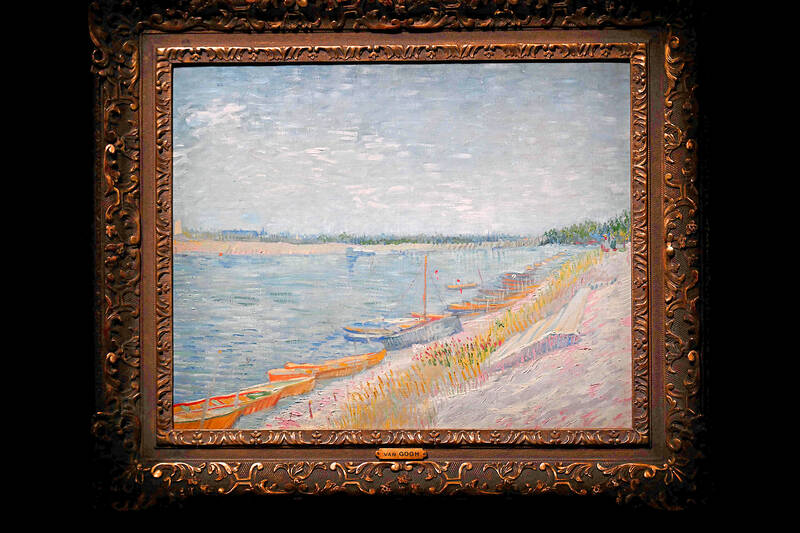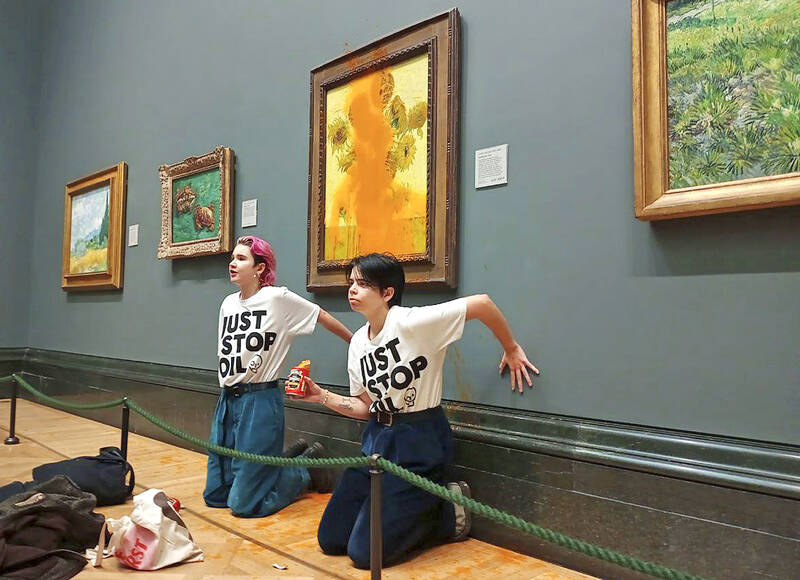Vincent van Gogh’s maverick talent has put him at the center of European culture for more than a century. His works make headlines when they sell, from the record-breaking moment his Irises went for £27 million (US$35.9 million) at Sotheby’s in 1987, right up to this month’s predicted hoopla in Hong Kong, where Christie’s are to auction his riverside scene, Moored Boats, painted two years earlier, for an estimated US$30 million to US$50 million — likely to set a record for works from his later, Parisian period.
The Dutch artist’s dramatic renderings of simple things — plants, trees, furniture and faces — are international emblems of the way we value art. So much so that London’s National Gallery’s renowned 1888 sunflower painting was deliberately targeted last year by Just Stop Oil climate activists, who lobbed the contents of a soup tin at it.
The yellow flowers, happily protected by glass, bloom on regardless and this weekend take up their rightful place alongside two other Van Goghs: a portrait of a mother figure, La Berceuse, and another 1889 vase of sunflowers, lent by the Philadelphia Museum of Art. The painter had always intended them to be shown together and now, courtesy of the National Gallery’s new bumper show, Van Gogh: Poets and Lovers, they are reunited for the first time since they were created in the artist’s studio in southern France. This time though, as Van Gogh expert Martin Bailey points out, they appear in “fancy frames.”

Photo: AFP
“The curators have done fantastically well to get all these loans, which include major masterpieces, such as The Bedroom and The Yellow House. They will have had to fight for every single one,” says Bailey, who blogs for the Art Newspaper.
“Exhibitions often take things chronologically, following an artist’s development, but here the paintings from Arles and from Van Gogh’s time in a nearby asylum at Saint-Remy are mixed together.
“They want us to focus on the painting and to put the myths to one side.”

Photo: AP
The show, marking both 200 years of the National Gallery and 100 years since the arrival of Van Gogh’s Sunflowers, opens to the public pre-labeled a “blockbuster’” the sort of must-see attraction museum directors dream of. It is also a term with a few unfortunate connotations, including the taint of safe commercial thinking.
But guest curator Cornelia Homburg, a renowned Van Gogh specialist, is confidently armored against this criticism. She is clear about the purpose of the show, which features 61 spectacular works, including some of the most revered and rarely, if ever, loaned.
“We want to show the artist rather than the tortured soul,” she says. “Of course, our interest is intensified by what we understand of his difficult life.”
Homburg concedes there is some relationship between Van Gogh’s suffering and his art, but stresses they are not the same thing. The key justification for the “blockbuster” she has been working on with Christopher Riopelle since early 2019 is its “solid premise.”
“We needed an angle that means something,” she says, “and the time Van Gogh spent in the south of France is the moment of creative maturity when he really thought about how to be a modern artist.”
So the exhibition challenges what we know, but not what we love about the painter. It updates the common idea that he was unappreciated in his time and that he strove, almost therapeutically, to express his troubled psyche on canvas.
As Homburg points out, while it is certainly true the artist was both poor and mentally ill, he did enjoy the respect of other artists and clung to a strong faith in his future audience.
“He thought about his public and the impact he would have. Everything was deliberate and planned,” she says.
“He knew he might not be widely understood in his day but believed that in 100 years he would be. He changed what he saw when he painted to make it more expressive, but not to express his own feelings. It was totally intentional.”
So if we sense trauma and melancholy in his twisted grove of olive trees trunks, or in a swirling skyscape, then it is because Van Gogh wanted us to, Homburg argues, and not because he felt that way himself.
Bailey agrees: “It is tempting to read meanings into the paintings but it is a mistake. There are a few from the asylum where you could say you see the effect of a mental struggle. This show has deliberately avoided those paintings.”
The gallery’s chosen title, Poets and Lovers, refers to the cast of characters and changing backdrops Van Gogh creates, playing with color to alter real faces and landscapes. Visitors first encounter two portraits, one of a dashing uniformed lover, and then one of a poet, imagined from the face of a painter friend, and bedecked with the firmament of stars that represent dreams for Van Gogh.
In the original painting of the artist’s bedroom in Arles, both these portraits can be spotted hanging above his bed. But in a second version, the one on display in London, Van Gogh romantically supplants these works with the 1889 Self-portrait, also in the show, and a painting of a mystery woman.
Later in the show, visitors meet a less familiar member of the Van Gogh dramatis personae in the 1888 Portrait of a Peasant, which reinvents an old gardener as a rural archetype. The work has never before been loaned to a UK institution by the Norton Simon Collection in Pasadena.
This is a show that leaves the clear impression that Van Gogh was always talking to his public — and even entertaining them.

A vaccine to fight dementia? It turns out there may already be one — shots that prevent painful shingles also appear to protect aging brains. A new study found shingles vaccination cut older adults’ risk of developing dementia over the next seven years by 20 percent. The research, published Wednesday in the journal Nature, is part of growing understanding about how many factors influence brain health as we age — and what we can do about it. “It’s a very robust finding,” said lead researcher Pascal Geldsetzer of Stanford University. And “women seem to benefit more,” important as they’re at higher risk of

Eric Finkelstein is a world record junkie. The American’s Guinness World Records include the largest flag mosaic made from table tennis balls, the longest table tennis serve and eating at the most Michelin-starred restaurants in 24 hours in New York. Many would probably share the opinion of Finkelstein’s sister when talking about his records: “You’re a lunatic.” But that’s not stopping him from his next big feat, and this time he is teaming up with his wife, Taiwanese native Jackie Cheng (鄭佳祺): visit and purchase a

April 7 to April 13 After spending over two years with the Republic of China (ROC) Army, A-Mei (阿美) boarded a ship in April 1947 bound for Taiwan. But instead of walking on board with his comrades, his roughly 5-tonne body was lifted using a cargo net. He wasn’t the only elephant; A-Lan (阿蘭) and A-Pei (阿沛) were also on board. The trio had been through hell since they’d been captured by the Japanese Army in Myanmar to transport supplies during World War II. The pachyderms were seized by the ROC New 1st Army’s 30th Division in January 1945, serving

Mother Nature gives and Mother Nature takes away. When it comes to scenic beauty, Hualien was dealt a winning hand. But one year ago today, a 7.2-magnitude earthquake wrecked the county’s number-one tourist attraction, Taroko Gorge in Taroko National Park. Then, in the second half of last year, two typhoons inflicted further damage and disruption. Not surprisingly, for Hualien’s tourist-focused businesses, the twelve months since the earthquake have been more than dismal. Among those who experienced a precipitous drop in customer count are Sofia Chiu (邱心怡) and Monica Lin (林宸伶), co-founders of Karenko Kitchen, which they describe as a space where they